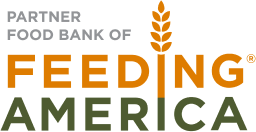Inflation escalates hunger
As the cost of groceries increases, so does food insecurity
By Amber Wright, Marketing
Most of us have already experienced the shock of inflation. Whether it was after ringing up the usual staples at the grocery store or at the gas pump, prices have increased all around.
Inflated prices means inflated need. Many Americans are finding their normal wages cannot stretch as far as they used to. To mitigate these financial challenges, many individuals and families turn to nonprofit organizations, like food banks, to provide the services needed to supplement their income. Yet the nonprofits comprising the social safety net are subject to the same economic circumstances as individuals. For this blog, we will look at the impacts of inflation and what it means for our organization.
Several causes have been credited as contributing factors to the current economic conditions. Much discussion has centered around the impacts of the COVID-19 pandemic, the war between Russia and Ukraine, and even instances of corporate profiteering.
The COVID-19 pandemic is perhaps the most obvious factor. Global shutdowns and labor shortages disrupted supply chains across the world. The Federal Stimulus package, while crucial to economic survival, caused demand to remain high while production was down. When demand outweighs supply, prices go up.
22 million jobs were cut from the U.S. economy during the pandemic. While most of those numbers have since been restored, inflation had already taken hold. Online commerce data shows consumers spent roughly $32 billion more for the same goods over the past two years.
The war between Russia and Ukraine has made its own impact on the global market. The two countries are major contributors of goods such as oil, gasoline, metals, fertilizers, wheat, corn, and soy. This disrupts countless goods and services that require any of those items for production. In addition to problems fueled by conflict, sanctions against Russia by the U.S. and other countries have further complicated matters.
Some speculate corporate greed is also playing a role. Manuel Bojorquez, a writer for CBS News, exemplified this with data gathered from Tyson, one of the four “meat giants” controlling 85% of the market. He demonstrated how the company was able to increase profits by 48% since 2021. Even after compensating for rising costs and increased wages, they are still making more money while average families struggle with inflation. Other businesses in the industry show similar results.
It is worth noting that Tyson, like many other corporations, have raised pay for workers by 20%. This is a common trend culminating in the fastest average wage increase in 15 years. The problem is that inflation still overshadows these gains, resulting in paychecks being worth nearly 2% less in terms of purchasing power.
The White House has expressed that inflation is typical following a pandemic and that this has been seen before in American history. The unfortunate timing of the Russia-Ukraine war has exacerbated issues, but measures are being taken to control the long-term outcome. The Federal Reserve is raising interest rates in order to quell economic growth, and therefore demand, until the supply is regulated. Unfortunately, it takes time for this to take effect. In the meantime, consumers can expect higher costs in the form of credit cards, auto loans, mortgage loans, student loans and other forms of borrowing money.
Key Points of Inflation
The current Consumer Price Index shows that inflation has risen 8.5% over the last year, which is the fastest rate seen in more than four decades. In April, it was estimated to cost the average American household an extra $327 a month to maintain their standard of living. The main areas dramatically affected include necessities such as food, fuel, and materials like metal and plastic that are found in packaging of nearly all retail items.
Food costs have repeatedly risen since 2020 and it is anticipated that this trend will continue. CNBC compared the current price for household grocery staples to costs last year. These essential items have jumped in price at the following rates over the last year:
Flour and prepared flour mixes: 14.2%
Butter and margarine: 14%
Meat, poultry and fish: 13.8%
Milk: 13.3%
Eggs: 11.2%
Fresh fruits: 10.1%
Bread: 7.1%
Fresh vegetables: 5.9%
Similarly, fuel has seen an extreme increase with crude oil at a staggering 70.1% annual increase and gasoline seeing a 48% price hike. Similar trends can be found among other forms of energy with electricity costs spiking 11.1%. Raw materials are another area suffering steep upticks. While prices are continuing to fluctuate, steel has seen a 74.4% increase and lumber an increase of 79.5% in cost over the previous year.
What This Means for Us and the Neighbors We Serve
As we all adjust our spending to compensate for various spikes in prices, we know the people most greatly affected are those already walking a financial tightrope. Low wages, redlining, discrimination, and other root causes of poverty have prevented many individuals from surviving without some way to supplement their income, even prior to the pandemic. Inflation is intensifying the problem.
The cessation of pandemic-related assistance programs has further reduced support for many. It is reasonable to assume that inflation is knocking more families into a financial crisis without these supplemental benefits. Like most food banks, we are seeing an increase in families served at our distribution sites, and we anticipate numbers will grow when the Public Health Emergency SNAP allotments end in the months ahead.
Need for food assistance is on the rise, and so are purchasing costs. About 65% of Feeding America food banks reported seeing a greater demand in March from the month before. While these organizations are buying the same amount of food this year compared to 2021, it is costing roughly 40% more.
Our non-profit is enduring similar trends. For example, an 8.45 oz. white milk used for our Good-to-Go-Backpack program cost us 50 cents apiece in September 2021. We were able to order 32,400 (totaling $16,200.) Just five months later in February 2022 the price increased to almost 63 cents apiece. At that price, securing the same amount increased more than $4,000.
Another example is the Honey Pepper Beef Sticks we also purchase for our Good-to-Go-Backpack program. This shelf stable, ready-to-eat source of protein is an important piece of our kid-friendly food packs. In August of 2021 we purchased 30,240 at 48 cents apiece (totaling about $14,515.) In February 2022 the price went up to 52 cents apiece, and so did our purchase for 68,544 (totaling about $35,643.) If the same amount had been purchased, it still would have cost over a thousand dollars more.
Another trend we are seeing among food banks is a decrease in donated product. Retailers are forced to tighten their spending as they are confronted with the same economic conditions. Labor shortages and supply chain issues disrupt their product flow as well. As a result, food donations are not as robust as they once were. Feeding America reported a 20% decrease in donations from food manufacturers and 45% less provision from the federal government for fiscal year 2022.
Accommodating a greater need can require additional time and space. Anyone who has waited in our Drive Thru distribution already knows that the wait times are getting longer, but we have remained to serve every car in line. We will continue to do so, rain or shine, as long as the need exists. Supply chain issues may not afford us the ability to purchase the items we want, but we will always provide the best within our means to create a well-rounded offering of food to our partners and customers.
Our warehouse is currently in the process of expanding to store and distribute more food. The current building had already reached max capacity with a yearly distribution of nearly 18 million pounds of food each year. While this process was underway before inflation got out of hand, we will continue to invest the time and money it requires to address increased food insecurity. The more food we can store, the more we can distribute.
We are committed to meeting the need in our community no matter what challenges we face. We have done so through a pandemic, tornados, and a county-wide water crisis, and we will do it again. We have honed the ability to pivot and adjust to the circumstances at hand. Our staff is rich with talent, compassion, and dedication, which will allow us to overcome obstacles in the path to fulfilling our mission. As we navigate the changing economic climate, we will remain firm in our efforts toward equity so that we can end hunger and its root causes. With the continued support of businesses and community members, we can weather whatever storm may lay ahead.




No comment yet, add your voice below!